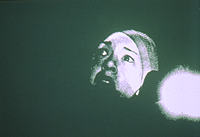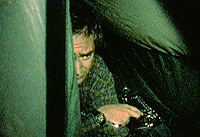
Boil a bean and double your trouble,
Pitch a tent and burst your bubble.
Run in circles, run in fright,
You might be the one tonight.
Those who don't get chopped might freeze;
can't see witches for the trees.
|
The Blair Witch Project
©Haxan film
Artisan Entertainment release
Photo courtesy MVSP Public Relations

|
Never heard of the famous Blair Witch before? Don't worry about it. Bet you have
now. The hip-hype gang that got together and made this little number probably never
dreamed that they would wind up with the biggest low-budget movie money-maker
ever or that their lives would be altered so substantially (onscreen as well as off). As
those damned witches say, "Don't fool around with Mother Nature."
Off into the woods go our own little Gretel and Hansels, better known as Heather
(Heather Donahue), Joshua (Joshua Leonard), and Michael (Michael B. Williams) to
shoot their "doc" on 16 mm stock while simultaneously keeping a record of
themselves and all their wearisome, tiresome, frustrating, and argumentative
moments on Hi-8 video. Before you get a chance to view any of this, however, the
facts (?) are laid out in front of you. The screen titles read:
On October 21, 1994, Heather Donahue, Joshua Leonard and Michael Williams
hiked into Maryland's Black Hills Forest to shoot a documentary film on a local
legend, "The Blair Witch." They were never heard from again.
This phrase has almost managed to forge its place, within a short space of time, into
cinematic history.
The Blair Witch Project
©Haxan film
Artisan Entertainment release
Photo courtesy MVSP Public Relations

|
It may be new to many, but it depends on lots of old fashioned devices and a keen
sense of logical structure. Preying on fears that most people possess instinctually,
the creators have molded the events to pry out optimal effect*. A group of "nice"
people go searching in unknown territory for tangible evidence related to a reputed
legend upon which they hope to capitalize through their movie making mania. They
don't really believe in ghosts (or even witches for that matter), so they regard it all as
a fun investigation. They interview the locals and relate their plans to them. They
intend to set up camp in the dark open spaces of the witch's confines. But
The Blair Witch Project
©Haxan film
Artisan Entertainment release
Photo courtesy MVSP Public Relations

|
sometimes things can go amiss. Ever lose your sense of direction? Ever get lost in
the dark? Ever been unable to find your bearings. Ever feel threatened by unknown
dangers? Ever felt like you're being hunted down? Then, the Blair Witch is just the
thing to get you shivers shuddering.
The documentary format makes it "feel so real." The so-called rediscovered
documentary footage shot by the three doomed filmmakers satisfies the American
appetite for reality programming as well as the increasingly prevalent thirst for
(alternative) religion and paranormal experience. Yes, let's face it, some people will
continue to persist in believing that this story is real simply because much of it is shot
on video. Many will undoubtedly insist that if Elly Kedward had not been banished
from Blair Township in 1785 nothing would ever have happened to these students in
1994. In using a simplistic approach, it has proven very effective. The applied
techniques lend themselves well to the intentions of the makers.
Definitely worth a viewing, especially because it has managed to capture an
important place in the historical perspective of cinema.
Filmmakers, hikers, and children, beware!
You might push the button for digital scare
And could easily wake up a new millionaire.
How's that for transfiguration?
|
*It's a shame that when this movie is screened in some countries abroad the brightness of the white
letters used for subtitles diminishes the effect of the darkness in the cinema. It's also a shame that
this never occurs to anyone watching it. After taking a survey of audience members' reactions,
several admitted that this aspect had never occurred to them and often added that they didn't found
the movie particularly scary or spooky. A pity this. Those dark moments, one of which lasts
exceptionally long (for a scene where nothing visible happens on screen), reminds one of William
Castle's "The Tingler" many years ago. When the screen became dark, "The Tingler" was supposed
to have broken loose among the audience, during which time viewers got the jolt of their lives. As the
film continued travelling into local theatres, the electrical machinery was dropped and the darkness
was all that remained. But the effect still worked. (Oh, by the way, there were no subtitles in
Brooklyn.)
© 1994-2006 The Green Hartnett
|

